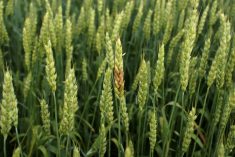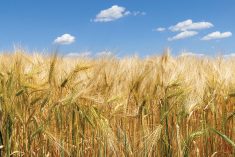A bad year for barley means maltsters and brewers will have to get creative on where and how they get their malt.
“The North American brewing industry in general is going to be facing a lot of challenges this year,” said Peter Watts, managing director of the Canadian Malting Barley Technical Centre (CMBTC).
Watts spoke to a class of farmers, agronomists and students during a November 25 and 26 session of CMBTC’s Malt Academy program. The group heard from malting and brewing industry and agricultural experts.
Canadians produced a fraction of the usual amount of malting barley — and what is there suffered from quality issues. Here’s what that means for the folks who make beer.
[VIDEO below] Manitoba Co-operator editor Gord Gilmour talks about the challenges barley growers faced in 2021 and if it has had an impact on that favourite beverage for many: beer.
The shortfall
Last year saw high demand for feed barley, but relatively slack demand for malt. This spring the outlook for malt barley was positive, though experts were already concerned about dry conditions.
In April, the Western Producer reported some growers were unhappy that malt barley was being contracted at only marginally higher prices than feed barley. One grower reported about a $0.50 premium above feed barley prices, which was selling for about $6/bushel.
Kevin Sich, supply chain director with Rahr Malting, said there simply wasn’t the demand to justify the premium.
“COVID hit the beer industry hard,” he told the Western Producer.
When it became clear that barley yields and quality were devastated by the western Canadian drought, the outlook changed drastically.
Maltsters immediately began looking for barley elsewhere, said Peter Schutz, a malt barley merchant with Richardson International.

Canada ended the 2020-21 year with very low barley stocks after a strong export program that year. In September, StatCan projected a 2021 barley crop yield of about 7.1 million tonnes (both malt and feed barley), down from about 10.7 million tonnes in 2020.
Watts suggested the actual figure will be lower.
“I think that the final production number of StatCan will have a six in front of it,” Watts said.
This means significantly less barley to export, said Schutz.
“The only export sales that have been made are the ones that were made six to 12 months ago,” he said. “There have been no new export sales ever since the crop started looking as bad as it has.”
Malt barley prices have skyrocketed. Last year the average price was about $5/bu., Schutz said. This year he’s heard of maltsters offering up to $11/bu.
Bad malt, bad beer
Much of existing barley has been of poor quality for malting. It’s been very high in protein, averaging 14 per cent, said Watts. It’s somewhat lower in weight and there has been some pre-harvest sprouting or chitting.
Kernel plumpness, surprisingly, has been pretty good, he added.
“These are plump kernels with high protein,” Watts said. “This is all sorts of uncharted territory.”

Why do these qualities matter? It starts with the malting process.
Malting barley involves soaking the grains in water to rehydrate them and allow the germination process to begin — this is called ‘steeping.’ The kernels are then kept under tightly regulated conditions so they don’t grow too quickly — this is ‘germination.’
These processes begin breaking down starches and proteins in the grain and turning them into extractable and fermentable materials, explained Yueshu Li, CMBTC’s director of malting and brewing operations. Vital enzymes also develop inside the grain.
After four to six days, when germination has advanced to satisfaction, the grain is ‘kilned.’ It’s dried with hot air and cured to halt germination and preserve the enzymes. Kilning also develops colour and aroma.
‘Specialty’ malts may be further roasted afterward for even more colour and flavour.
The malt is cleaned of rootlets, peeled husks and other undesirables, and then aged.
For efficiency, maltsters prefer to keep processes as predictable as possible. That’s why buyers or maltsters ‘select’ malting barley through a series of lab tests including sprouting the grain to find its viability and determining varietal purity, moisture, protein and other factors.
The higher the protein, the slower the kernels take on water during the steep, said Doug Munro, the North America merchandising manager with Boortmalt. It has less starch, and therefore less “extract” to ferment.
High protein can affect beer’s flavour and can cause cloudiness, Munro added.
As a rule, maltsters prefer 10 to 12 per cent protein, Munro said. Export markets may prefer higher.
Brewers who use ‘adjuncts’ like rice or corn syrup alongside barley in their beer generally prefer higher-protein malts, as these bring more enzymes to the mixture, Watts said.
Low kernel ‘plumpness’ means less fermentable extracts, and more waste, said Munro.
Malt barley must also germinate well — at least 95 per cent of 100-kernel samples must germinate in tests. If grain is chitted (sprouted prior to harvest) it won’t germinate as well in the malting process, leading to waste.
Chitted barley is very water sensitive, Munro added. It requires more attention during malting.
Maltsters also want varietal purity, as each variety (e.g. CDC Copeland versus AAC Synergy) will react differently to malting conditions. They want at least 95 per cent purity, said Schutz.
Post-malt, they can blend varieties.

Finding malt
This year, however, maltsters are making concessions.
“If it’s the only thing available, they have no choice than to brew with it,” Schutz said.
Poor barley means more work, he said. It takes tweaking of parameters during malting so it can still produce beer.
To make up for shortfalls, maltsters are considering importing barley to Canada, said Schutz.
This isn’t easy.
“Canada’s built for exporting. It’s actually pretty difficult to import stuff into Canada. There’s no infrastructure for it, especially on the West Coast,” Schutz said.
While Richardson has not imported barley, said Schutz, he’s heard of malt plants that can receive ships in Montreal and Thunder Bay bringing in barley from Europe. They can blend the lower-protein European barley with high-protein Canadian barley to increase usable supply.
Maltsters are also looking at Australian barley, though that adds a level of logistical difficulty as western ports are not built to receive it. Shipping to Montreal is very much the long way around, and due to U.S. regulations, it can’t be shipped into the States and trucked up to Canada, Schutz said.
Aluminum cans are also in short supply following a slew of supply chain issues.
Watts explained that just under 75 per cent of beer sold in Canada in 2020 was canned, up 12 per cent from 2019.
So, does that mean the price of beer is going up? Probably.
“I think we will see beer prices rise a little in Canada due to raw material increases, aluminum shortages etc.,” Watts told the Co-operator.
FCC data from the beginning of October showed the price of beer had gone up about one per cent so far this year.
















